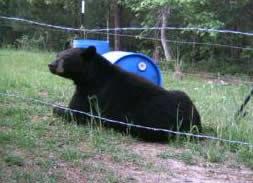 October 24, 2017 - As cool temperatures enter Texas and hard mast begin to drop, deer, pigs and squirrels may not be the only native species seeking nutrient dense acorns and hickory nuts in preparation for winter. The black bear, whose native range once spanned all of Texas, has begun a revival in portions of its native territory after original populations were extirpated through loss of habitat and over harvesting throughout the 19th and 20th centuries. The sporadic, temporary reappearance of this keystone species in east Texas is due in large part to the recovery of black bears in the neighboring states of Louisiana, Arkansas and Oklahoma.
October 24, 2017 - As cool temperatures enter Texas and hard mast begin to drop, deer, pigs and squirrels may not be the only native species seeking nutrient dense acorns and hickory nuts in preparation for winter. The black bear, whose native range once spanned all of Texas, has begun a revival in portions of its native territory after original populations were extirpated through loss of habitat and over harvesting throughout the 19th and 20th centuries. The sporadic, temporary reappearance of this keystone species in east Texas is due in large part to the recovery of black bears in the neighboring states of Louisiana, Arkansas and Oklahoma.
Since 1977, Texas Parks and Wildlife has documenting black bear sightings and deaths in East Texas. In some cases, the Texas Parks and Wildlife Department has documented multiple sightings over the period of a year, while other years have yielded no sightings. In East Texas, the vast majority of sightings have been of male black bears, who disperse from neighboring states in an attempt to establish a home range unoccupied by another male. Because there is no resident female population in East Texas, however, biologist speculate that those males eventually return to their home state in search of a mate. In portions of west Texas, however, natural recolonization from populations in Mexico and New Mexico has resulted in small breeding populations located primarily in the regions of Big Bend and the Guadalupe Mountains.
Suitable areas of habitat capable of sustaining a small bear population have been identified in East and West Texas in separate studies conducted by researchers at Stephen F. Austin State University’s Arthur Temple College of Forestry and Agriculture and Sul Ross University’s Borderlands Research Institute.
Because black bears are considered rare in Texas, wildlife biologists from the Texas Parks and Wildlife Department investigate all alleged sightings to confirm or refute reported observations. After an investigation is completed, a sighting is assigned one of three classifications: Class I, II or III. Most reliable is a Class I sighting that provides verifiable physical evidence such as scat, a paw print, fur or a photograph. Somewhat less reliable is a Class II sighting with detailed accounts provided by an experienced observer, such as a biologist or veteran outdoors person, but provides no physical evidence. Finally, a Class III sighting includes a vague report and/or the account of the animal seen is not consistent with the image or behavior of a bear, or the investigation reveals falsification of essential facts. Black bear are state-listed as a threatened species, meaning it is illegal to kill or harm a black bear in Texas, with violations carrying significant fines, possible jail time and loss of hunting privileges.
Within the past several years, multiple landowners have provided photographs of black bears taken by motion sensitive cameras mounted at deer feeders. Landowners are not obligated to implement any special management practice when a sighting on their land is reported. Biologists from the Texas Parks and Wildlife Department simply use this information to track trends in bear sightings to guide future wildlife management practices. Hunters are encouraged to report sightings and to “know your target,” as from a distance a black bear can be mistaken for a feral hog or javelina.
People and black bears in suitable rural habitat presently co-exist amicably across the nation, and the Texas Black Bear Alliance advocates that Texans can undoubtedly co-exist peaceably with black bears as well.
Founded as a task force by the Texas Parks and Wildlife in 2005, the Texas Black Bear Alliance was renamed and reorganized in 2016 as a non-profit, non-governmental organization of private citizens who seek to promote the restoration of black bears in suitable habitat throughout their historic range in Texas through partnerships using education, research and habitat management.
Individuals who believe they have seen or have evidence of a black bear should call Texas Parks and Wildlife at (903) 566-1626 ext. 209. Information regarding black bears in Texas, as well as the Texas Black Bear Alliance may be found at www.texasblackbear.weebly.com. The Texas Black Bear Alliance is also on Facebook.









